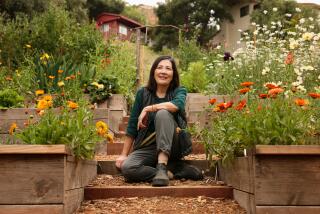Twist and Shout (or How Good Backs Turn Bad)
Cindy Shaw knows when spring has arrived by the amount of weeds in her garden and the number of pain-wracked gardeners who seek her help.
Shaw, a physical therapist, is the owner and director of Orthopedic and Spine Care Physical Therapy in Santa Ana and Huntington Beach.
“I treat a lot of professional gardeners and garden hobbyists for back strain, shoulder strain and neck problems from overhead work like tree trimming,” she said. “The most common problem is repeated bending over, aggravated by twisting.”
She points out that it rarely is just one task that causes back spasms. Instead, it’s repeated motions of which backs aren’t really capable.
“It isn’t bending over to pull one weed that does the damage,” she explained. “It’s insisting on getting the 20th weed when your back is already sending out distress signals.”
Mary Lou Heard, owner of Heard’s Country Gardens in Westminster, knew she was in trouble when she lifted a flat of plants above her head while trying to put them on a shelf several feet in front of her.
“Waves of pain radiated through my lower back,” she said.
This isn’t an unusual occurrence for her. Lower back pain has bothered her for years, but hasn’t stopped her passion for gardening. But it does send her to a chiropractor several times a month.
She gets treatment from Kip Wieberdink, a chiropractor affiliated with the Southern California Pain Control Center, with offices in Garden Grove and West Covina. He is sympathetic to Heard’s plight because he suffers from chronic lower back problems.
“Digging a hole messes me up, even though I use stringent body mechanics,” he said.
Those body mechanics include contracting abdominal muscles while working, keeping the body in alignment and providing support for a weak lower back.
He also said the lower back is able to bend forward and back, but shouldn’t be twisted. Twisting is the most common injury.
Gardeners use bad back posture when they reach to one side and twist the upper torso while grabbing a weed. Gardeners are also likely to sit or squat near a planting bed and twist as they work. Or they may try to lift that 2-cubic-foot sack of planting mix from the car trunk without help, support or correct posture.
Wieberdink and Shaw offer hope to garden enthusiasts who want to enjoy their hobby without accompanying back pain.
Shaw said gardeners can learn from athletes who prepare their cold muscles by stretching.
“So many people rush out to their gardens at the first sign of spring and tackle long garden projects without warming up first,” she said. “They also work too long.
“I tell people to warm up by walking for a few minutes. Then stretch gently from side to side, and forward and backward. When they garden, it’s better to start with short projects and work up progressively.
“In repetitive tasks like weeding, alternate right and left hands. Also, stop during a project, stand and again stretch gently to counter-stretch the muscles being worked,” she said.
She said people should listen to their backs.
At the first twinge of discomfort, take a break. Don’t push to complete the project. She recommends buying gardening implements to prevent trouble.
“There are some great padded stools that let people sit and scoot from place to place,” she said. “Padded kneelers or even sports kneepads are great for people whose knees are strong enough for kneeling.”
Wieberdink advises gardeners to use tools that fit their bodies.
“People should be sure that their shovels, rakes and hoes have handles of the right length for their bodies,” he said.
For gardening, people with chronic back trouble should exercise to strengthen weak abdominal, hamstring or other muscles.
“People should see their doctors or health-care specialists to get exercises that are specifically designed for their individual problems,” Shaw said.
Shaw loves to garden with her children, Amy, 10, and Keith, 7. One recent sunny afternoon, they planted a flat of impatiens in their Huntington Beach garden. While she guided them in placing the plants, she also aided them in the correct methods to lift, kneel and plant.
“Gardening is a wonderful activity and a gift we can give our children,” she said. “And by teaching them good posture and body mechanics now, it will make a big difference when they’re older.”
(BEGIN TEXT OF INFOBOX / INFOGRAPHIC)
Tips to Good Garden Posture
* Avoid reaching forward by keeping as close to the work as possible.
* Don’t twist.
* Take frequent breaks and lightly stretch the muscles being worked.
* Alternate using right and left hands.
* Don’t bend from the upper back. Instead, bend the knees or bend forward from the hips.
* Don’t lift heavy sacks or pots by yourself.






